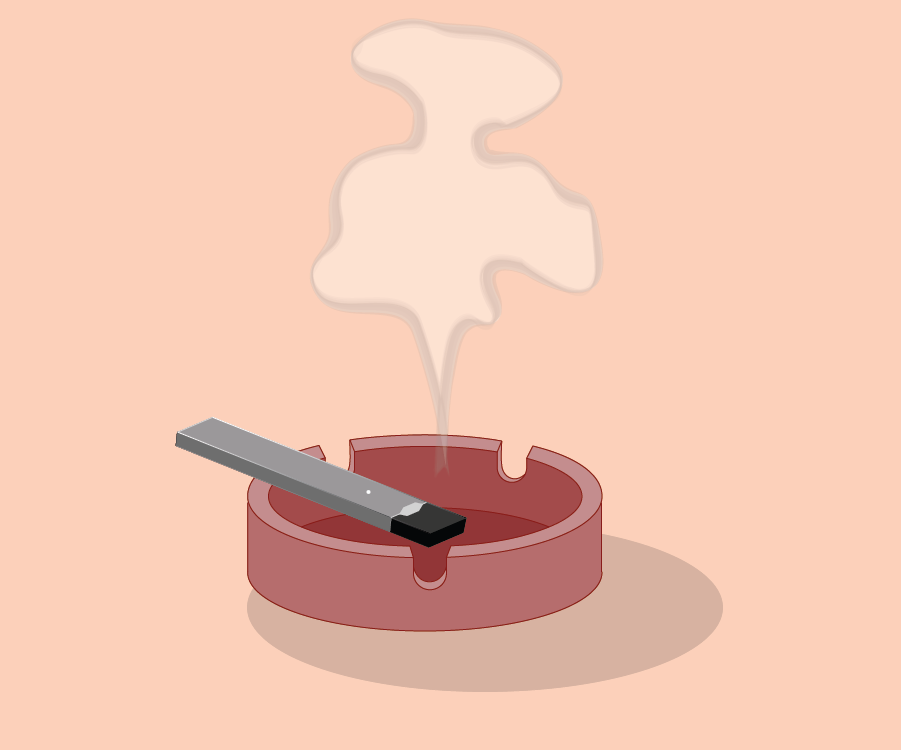The Food and Drug Administration threatened to ban the sale of the e-cigarette brand Juul and four other brands unless the company can prove in 60 days, starting Sept. 12, that they don’t market to minors. The FDA conducted a surprise raid on Juul’s headquarters in San Francisco on Sept. 28, confiscating more than 1,000 documents with the goal of finding evidence that the company has been targeting youths. Juul had already provided the FDA with more than 50,000 documents at its request, according to a New York Times interview with Kevin Burns, the CEO of Juul.
This potential ban however, is not an effective way of aiding in the health of users. It won’t keep Juuls and similar products out of the hands of minors. Instead, it will allow counterfeit vape juice devices to take over the market with little to no regulation on harmful additives and chemicals. In the end, regulation is always safer than prohibition.
I’ve been using nicotine products for about eight years, starting at the age of 13, as did many of my friends in my home state of South Carolina. My first tobacco of choice was Copenhagen snuff, a moist product that is consumed by placing a wad between one’s teeth and lower lip and spitting a tar-black juice to avoid throwing up. I learned this habit from my father, who has been a snuff user for more than 40 years and who suffers from debilitating anxiety, as almost everyone in my family does. I quickly made the switch to cigarettes during my freshman year of high school, after witnessing my father’s first gum graft — a result of the fiberglass shards that were once a snuff additive and the general corrosive effect that tobacco has on gum tissue.
For six full years after this switch, I was a regular smoker of Marlboro Reds and Golds. At first, I was hiding the habit until my addiction increased to at least a pack per day. This habit waxed and waned depending on my anxiety and stress levels, but I often went through stints where I couldn’t maintain a baseline level of sanity without at least two full packs a day.
Today, I have finally been able to free my lungs and wallet from the bondage of cigarettes, thanks only to the Juul device.
Juul has made a name for itself by creating sleek devices that burn a heavy nicotine-salt blend in the form of “pods.” These pods come in packs of four, costing about $20, and come in flavors like mint, menthol, tobacco and mango. Opponents of legal Juul pods argue that these flavors and the sleek design of the Juul device have been purposefully constructed to appeal to younger users and minors.
It hits the throat with a satisfying harshness, mirroring cigarettes far better than tanker vapes, and produces a thin, small vapor upon exhalation, which contrasts the unnecessarily massive clouds of vapor that are produced by tankers. Additionally, $20 toward a pack of Juul pods provides the same amount of nicotine as four packs of cigarettes, as each pod is equivalent to a pack, and they are sold in fours. A decent pack of cigarettes costs about the same. Juuling is four times as affordable.
This claim seems to have some merit, as a recent Center for Disease Control study reports that high school vaping rates have increased eightfold from 2011 to 2017, according to CDC data, referenced in a Reuters special report on Juuling.
While smoking has decreased from 15.8 percent of high school students in 2011 to 7.6 percent in 2017, vaping has increased from 1.5 percent use to 11.7 percent during the same period, according to the same CDC data.
However, a Public Health England (PHE) government-funded study published in February stated that “vaping poses only a small fraction of the risks of smoking and switching completely from smoking to vaping conveys substantial health benefits.” The study also stated that e-cigarettes “could be contributing to at least 20,000 successful new quits per year,” in the U.K alone.
Professor John Newton, the director of Health Improvement at PHE said, “Our new review reinforces the finding that vaping is a fraction of the risk of smoking, at least 95% less harmful, and of negligible risk to bystanders. Yet over half of smokers either falsely believe that vaping is as harmful as smoking or just don’t know.”
Professor Linda Bauld, an author and Professor of Health Policy at the University of Stirling and Chair in Behavioural Research for Cancer Prevention at the Cancer Research Center UK said, “Concern has been expressed that e-cigarette use will lead young people into smoking. But in the UK, research clearly shows that regular use of e-cigarettes among young people who have never smoked remains negligible, less than 1%, and youth smoking continues to decline at an encouraging rate.”
Juul Labs currently holds 70.5 percent of the United States e-cigarette market, according to a multi-company report by Nielsen Total US x AOC/Convenience Database & Wells Fargo Securities, LLC. Their sales have increased dramatically from 2.2 million devices in 2016 to 16.2 million in 2017, according to a CDC study released on Sept. 25, published in the Journal of the American Medical Association. The other devices that are being targeted by the potential ban are Fontem Ventures BV’s blu, Altria Group Inc.’s MarkTen and British American Tobacco Plc’s Vuse and Logic.
The likely outcome if Juul devices and pods are banned in the United States is that the blossoming illegal pod market will explode and lead to far more intensive health impacts than before, as a result of their lack of regulation. Juul’s official website states that “through years of research, JUUL Labs developed its proprietary e-liquid formula, which is mixed under strict quality controlled processes utilizing industry leading U.S. partners. Our ingredients include glycerol, propylene glycol, natural oils, extracts and flavor, nicotine and benzoic acid.”
Although these statements must be read with some skepticism, the company’s ingredients have been evaluated by the FDA, while the exact ingredients making up illegal pods are unknown, as are their potential health hazards. The parent company of Juul Labs, PAX Labs, recently filed trademark claims against over thirty Chinese manufacturers of counterfeit pods and Juul brand devices online, according to a statement made by the company on Sept. 11.
For me, returning to cigarettes isn’t really an option, as the city’s tobacco taxes have made them inaccessible. I’m far more likely to use unregulated vaping products to avoid this cost, leaving my health in the hands of unregulated manufacturers.
A current example of a failed ban is our continuing prohibition of marijuana, which has put billions in the hands of cartels and gangs, and led to an unregulated market full of horror stories. In addition, the proliferation of unregulated, synthetic cannabinoids, often referred to as spice or K2, resulted in 28,521 related hospital visits in 2011 alone, according to the National Institute on Drug Abuse. If Juul pods were made illegal, it seems likely that such visits would occur as a reaction to unregulated pods. In the end, regulation is simply a safer and more profitable method than prohibition.







